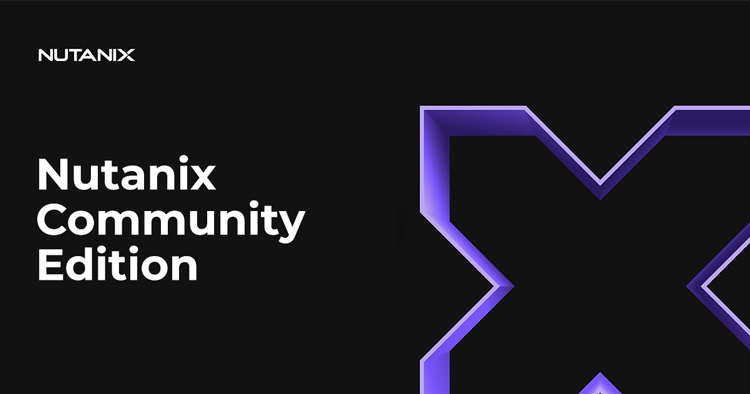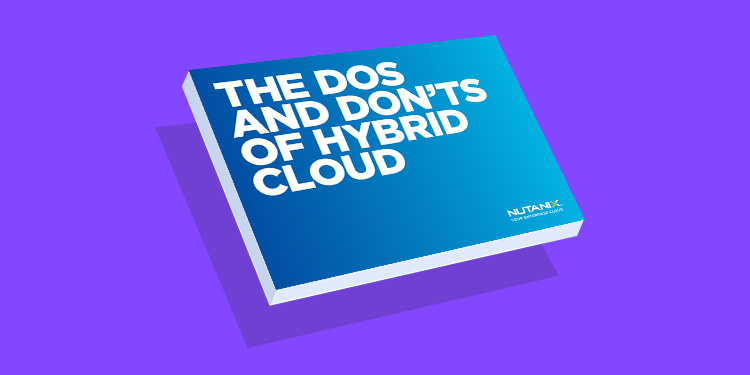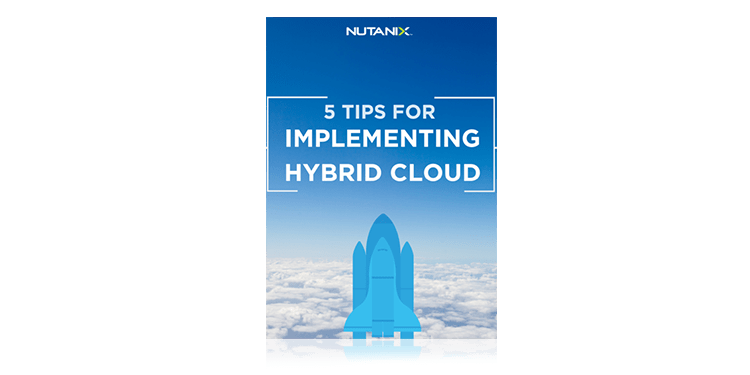What is hybrid cloud?
Hybrid cloud is a type of cloud computing environment that combines elements of both public and private clouds. It allows organisations to use a combination of on-premises, private cloud, and third-party public cloud services to manage their data, applications, and workloads.
In a hybrid cloud environment, the private cloud can be used for sensitive data and applications that require high security, compliance, and control, while the public cloud can be used for less sensitive data and applications that require high scalability, availability, and cost-effectiveness. The combination of both environments provides greater flexibility, agility, and cost optimisation for organisations.
Get hands-on experience with the Nutanix Cloud Platform on your own hardware. Register today!

How does hybrid cloud work?
The arrival of cloud computing to enterprise IT brought much more than new business value and end-user utility. An entirely new set of terms was created to describe the many varieties of virtual data storage and transmission.
Traditional cloud architecture
First, we learned about private clouds, or virtualised environments that were created so that users within that organisation could access servers and other resources needed in an on-demand fashion to support their organisation’s workloads without any sharing of those resources outside their organization. Private cloud infrastructure like this is usually, but not always, created utilising resources within a company’s own on-premises data centre. Then as time progressed, someone told us about public clouds, or clouds that are publicly accessed and consumed. This means that all hardware-based networking, storage, and compute resources are owned and managed by a third-party provider like Amazon Web Services (AWS), Microsoft Azure, or Google Cloud Platform (GCP). Though workloads are partitioned for data security, these resources are shared by the customers of a particular public cloud provider. The big advantage of public clouds was not having to manage the resources yourself and much more agility than you could get in your on-prem environment.
What is hybrid cloud architecture?
Hybrid cloud architecture is the design and implementation of a cloud computing environment that combines elements of both public and private clouds. A hybrid cloud architecture typically includes a mix of cloud computing models, such as Infrastructure as a Service (IaaS), Platform as a Service (PaaS), and Software as a Service (SaaS), as well as various deployment models, such as on-premises, private cloud, and public cloud. It also includes networking, security, and management tools to ensure seamless integration and interoperability between different cloud environments.
The design of a hybrid cloud architecture depends on several factors such as:
Business and IT requirements - The specific requirements of an organisation for scalability, agility, security, compliance, and cost-effectiveness determine the design of a hybrid cloud architecture. For example, an organisation that requires high security and control over their data may choose to use a private cloud for sensitive workloads, while an organisation that requires high scalability and cost savings may choose to use a public cloud for non-sensitive workloads.
Workload characteristics - The characteristics of workloads, such as data volume, processing power, and storage requirements, also influence the design of a hybrid cloud architecture. Workloads that require high performance may be run on a private cloud, while workloads that require high scalability may be run on a public cloud.
Connectivity requirements - The design of a hybrid cloud architecture also depends on the connectivity requirements between different cloud environments. This includes establishing connectivity between on-premises infrastructure, private cloud resources, and public cloud services, as well as ensuring data and application portability across different cloud environments.
Compliance and regulatory requirements - Organisations that operate in regulated industries or regions must comply with specific regulatory requirements, such as data privacy, security, and compliance. The design of a hybrid cloud architecture must consider these requirements to ensure that data and applications are secure and compliant.
Budget and resources - The design of a hybrid cloud architecture also depends on the budget and resources available to an organisation. Organisations must balance the cost savings of using public clouds with the cost of managing and securing a hybrid cloud environment. They must also consider the availability of resources, such as IT staff, to manage and maintain a hybrid cloud environment.
Hybrid cloud examples
According to the Enterprise Cloud Index, the vast majority of 2024 survey respondents (80%) selected hybrid cloud as their ideal IT operating model. Below are just a few examples showcasing how hybrid cloud can be used. Hybrid cloud implementations can vary widely depending on the specific needs and requirements of each organisation.
Private and public cloud
Companies often use both public and private cloud in their in their strategies for data storage and processing. A company might employ a private cloud setup for storing sensitive customer data, while opting for public cloud services like AWS or Microsoft Azure for less sensitive data or tasks demanding substantial computational resources. By using a combination of private and public clouds, the company can optimise both security and scalability, benefiting from the flexibility and cost-effectiveness of public cloud resources while maintaining control over critical data assets.
On-premises data centre and public cloud
Retail provides an excellent example of utilising both on-premises data centres and public cloud services. A retail corporation uses an on-premises data centre for essential tasks like inventory management and customer data storage. During busy periods like holiday sales, they turn to public cloud services to scale up infrastructure. This hybrid approach ensures reliable day-to-day operations while effectively managing sudden surges in workload.
Multiple public clouds
A multinational technology corporation might employ various public cloud providers to enhance its global operations. For example, it could utilise one provider for scalability and a wide range of services in one region, while utilising a different provider in another region due to its compatibility with specific applications and services. By leveraging multiple public clouds, the company can capitalise on the strengths of each provider while maintaining flexibility and avoiding vendor lock-in.
Edge computing and public cloud
In the healthcare industry, a hospital may employ edge computing devices, such as wearable health trackers or remote patient monitoring systems, to collect real-time patient data at the point of care. This data is then processed locally on the edge devices to provide immediate insights or trigger alerts for critical conditions. Simultaneously, the hospital utilises a public cloud infrastructure to aggregate and analyse this data on a larger scale, facilitating long-term trend analysis, predictive modeling, and population health management. By combining edge computing for immediate data processing with the public cloud for broader analytics and insights, the hospital can enhance patient care, optimise resource allocation, and improve overall operational efficiency.
Benefits of hybrid cloud computing
The adoption of a hybrid cloud service model offers a range of benefits that can revolutionise the way organisations approach their operations.
- Flexibility and agility - By far the most important benefit of a properly architected hybrid cloud is increased business agility. You have ready access to resources to support new applications, accommodate development and testing projects, or to quickly address unanticipated needs within your hybrid cloud environment. In an ideal world, workloads can be moved quickly between on-premises and cloud locations, and leverage resources from multiple locations. (Unfortunately, API and architectural differences between different cloud providers make this challenging).
- Elasticity - Many industries experience big variations in resource demand. One clear example is retail, where activity spikes before the December holidays. With a hybrid cloud model, you can dynamically adapt to these fluctuations in resource demands, ensuring smooth scalability of your hybrid cloud solutions. In a similar vein, many individual applications have big fluctuations in resource demand. Such applications need to run in an environment where they can grab resources when they are needed and release them when they are not, reducing overall expenses.
- Self-service - A well-designed hybrid cloud can allow IT users - such as developers and line-of-business managers - to gain access to IT infrastructure and services through a self-service portal. This not only gives them immediate access to services, it reduces the burden on IT since it no longer has to serve as the middleman.
- Faster delivery of new products and services - Hybrid cloud computing can help you deliver new products and services more quickly by eliminating barriers that slow your business and development teams down. New digital services become easier to create and deploy, and developers and test engineers can better access the resources they need when they need them, leveraging hybrid cloud services.
- Cost control - A hybrid cloud model lets you run every application as efficiently as possible, while adopting a pay-as-you-go model that reduces your capital investments in infrastructure and data centres. Designing data centres to accommodate peak loads only to have infrastructure sitting idle much of the time is a poor choice versus adding cloud resources when needed to accommodate peak periods.
- Avoidance of lock-in - If you adopt a cloud-only model, it’s almost impossible to avoid getting locked into one or two cloud vendors. It can be cost-prohibitive to get your data out of the cloud, so you need to exercise caution before you move data from data centres into the cloud.
- Access to the latest technology - In today’s competitive business environment, enterprises cannot afford to find themselves in a situation where they are unable to gain immediate access to technologies that could provide a business advantage. One example of this is AI. The large public clouds are innovating rapidly and offering competing services. A hybrid cloud model gives you the flexibility to use the best technology to seize opportunities.
Difference between hybrid cloud and multicloud
What about environments that utilise both public and private cloud infrastructures but data may or may not be shared between them? How do we categorise this scenario?
This term associated with this new hybrid cloud architecture is called a “multicloud environment”. These types of cloud environments differ from hybrid clouds, as they imply the presence and usage of multiple clouds without the guaranteed interoperability between them. Utilisation of this emerging architecture is growing as it provides access to several service models within the cloud.
One common misconception when comparing hybrid cloud and multicloud infrastructures is that the two are mutually exclusive. The explicit definition of a multicloud environment, meaning more than one, suggests that a hybrid cloud model is indeed a type of multicloud model. However, the inverse is not always true. While a multicloud configuration can be hybridised, it can also exist without the need for individual clouds to communicate with each other.
The most obvious reason for this siloed approach is data security. Despite having data encryption and other threat prevention capabilities, cloud operators still fear the exposure to risks associated with moving data in between clouds. That doesn’t mean, however, they won’t need to use many clouds at one time. Organisations from both the public and private sectors are increasingly presented with business justifications for managing workloads amongst several cloud providers. In these instances, the clouds are running multiple tasks. Clouds aren’t sharing data or computational power for a single output like in the case of the hybrid environment. Aside from security, many organisations literally stumble into a multicloud environment as they don’t have a business justification for sharing apps or data between clouds.
Keep your cloud environment secure
In a recent analyst report on cloud strategy leadership, several industry leading analysts concluded that the security posture of major cloud providers is as good as or better than most enterprise data centres. Security should no longer be considered a primary inhibitor to the adoption of public cloud services. However, it is not as simple as moving on-premises workloads to the cloud. Security teams should look to leverage the programmatic infrastructure of public cloud IaaS. Automating as much of the process as possible will remove the potential for human error — generally responsible for successful security attacks. Keeping track of security controls needs to be programmatic for ensuring complete cloud compliance.
While a hybrid and multicloud strategy has many benefits, it creates a real risk that your enterprise data becomes fragmented. Lack of visibility can make it very difficult to identify and track data resources, including where they are and whether or not they’re adequately protected. Reports of data left unprotected in the public cloud add to enterprises’ concerns about storing critical data there. In many cases these data sets were exposed simply because operators weren’t familiar with the security model and tools in a given cloud. To ensure that you have the proper visibility and security over your clouds—public and private—make sure you enforce a “security-first” model that maintains continuous monitoring and management of cloud security risks and threats. This model will leverage innovative tools and automation that detect security threats in real time, act on those threats, and measure security and compliance results. Evaluate and add tools that monitor cloud security and governance continuously, performing automatic health checks on a regular basis, and understand that in a public cloud world security is a “shared responsibility” between the user and the cloud vendor.
Why choose hybrid cloud?
Hybrid cloud computing is becoming more popular due to its ability to provide organisations with the best of both worlds - the scalability and cost-effectiveness of public cloud services and the control and security of private cloud infrastructure. This flexibility allows organisations to choose the most appropriate cloud environment for each workload or application, optimising cost, performance, and security. In addition, hybrid cloud allows organisations to easily scale their IT infrastructure to meet changing demands while maintaining control over their data and applications. The need for greater agility, innovation, and efficiency is driving the adoption of hybrid cloud computing among organisations of all sizes and industries, and it is expected to continue to grow in popularity in the years to come.
How to create a hybrid cloud strategy?
Your enterprise needs a cloud operating system that gives you the ability to monitor, manage, and orchestrate across all environments using a single set of tools. Most approaches to hybrid cloud are based on a strategy of trying to determine the best way to make all the disparate pieces—legacy infrastructure in your data centres, public clouds, and cloud service providers—somehow work together. Based on the realities of the current cloud environment, this approach has a higher likelihood of success:
- Choose a single framework—a “cloud operating system”—that will allow you to manage workloads on-premise and in the cloud.
- Modernise your on-premises environments in accordance with that framework.
- Choose only public clouds and cloud service providers (CSPs) compatible with that framework.
Private cloud functions as the foundation of a hybrid cloud strategy. The ideal core of that private cloud foundation is a hyperconverged infrastructure core. The efficacy of this approach is contributing to the more than 70 percent of organisations now repatriating workloads back on-premises.
Nutanix provides the fastest path to hybrid environment
In today’s digital innovation era many organisations need to operate their applications and data in an environment spanning on-premises private clouds and public clouds. It does not need to be difficult. Expanding from private to public cloud can pose challenges, including the need to manage complex networking, re-architecting applications, managing multiple infrastructure tools for various clouds, security and more. What is essential is a unified hybrid cloud platform capable of extending across private, distributed, and public clouds, enabling operators to manage their traditional and modern applications using a consistent cloud platform.
Nutanix delivers the industry’s first hybrid multicloud platform with the flexibility, simplicity and cost efficiency needed to run applications in private or multiple public clouds. Nutanix extends the simplicity and ease of use of Nutanix hyperconverged infrastructure (HCI) software as well as the full Nutanix stack to public clouds like AWS and, soon, also on Azure. Using the same platform on private and public clouds, Nutanix dramatically reduces the operational complexity of migrating, extending or bursting your applications and data between clouds. This hybrid cloud solution allows operators to use a single management plan to truly manage both their private and public cloud infrastructure managed and operated as a single cloud.
Related resources:
Explore our top resources

Delivering on the Promise of Hybrid and Multicloud Deployments

Get hands-on experience with the Nutanix Cloud Platform on your own hardware.




